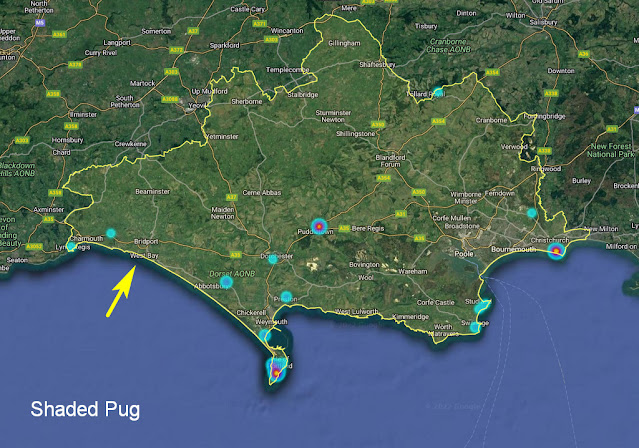Seawatchers at Galley Head, County Cork, today recorded 617 Cory's Shearwaters, 7 Greats, 230 Sooties, 7 Long-tailed Skuas and 10 Sabine's Gulls, plus the usual dross of course. West Bay is similar to Galley Head, in that it has sea just offshore, so I was a bit disappointed with the paltry tally my 40 minutes this evening produced: 13 Gannets, 1 Manxie and a Med Gull. Ah well...
Thank goodness for moths.
Our smallest catch so far is 19 moths of 11 species, three nights ago. But even that lot contained a new one for us...

|
|
Named after the little fin poking up on its head, apparently. |
The following night, again a single new moth...

|
|
A tick, yes, but not exactly a looker. |
Last night, four new species. And this time there was a real cracker...

|
|
What a classy-looking moth! |

|
|
Needed assistance to identify this one correctly. Currant Pug is
very similar. As usual, a tiny bit further up the learning curve as a
result. |

|
|
Superficially similar to - and roughly the same size as - a micro we
caught a couple of weeks ago, Tortrix viridana* (Green Oak Tortrix), but this one is a macro-moth. |

|
|
Have caught this one previously, but bailed out of the identification
challenge |
Our list stands at 119 currently, and I am pretty confident that all those have been correctly identified. At the beginning of the month I was having to look up just about every single moth. Talk about laborious. Now I am identifying two-thirds or more without needing to check. It definitely feels like progress is being made. I can even remember a small number of those annoying scientific names by which micros are generally known. All good.
However, the best thing about this mothing lark is the sheer diversity in each catch. Last night, for example, 33 moths of 23 species. In addition, almost every catch includes a 'quality' moth or two. To put this into a birding context, imagine that your local patch is a reasonable wetland. Every day there will be a selection of waders on offer. Dunlin every day (in moth terms, think Heart and Dart), plus Redshanks (Large Yellow Underwing) and a few Ringed Plovers (Riband Wave). Occasionally there will be some 'quality' - species like Little Stint, Avocet, Spotted Redshank, Curlew Sandpiper etc, species that you might normally record between one and five times a year perhaps. In birding, that list of quality species is relatively short, and you definitely will not be bagging one too often - once a week would be great. Moth-wise it feels like the list is endless, and that we get one or more almost every night! Certainly, in less than a month our modest Bridport trap has caught plenty of moths which are locally uncommon or scarce, or better. Take that Wormwood Pug above, for example...

|
|
That little blob by Bridport and West Bay represents 10 records of
Wormwood Pug in the last five years. Our single last night is possibly
just the 11th recorded locally since 2017. |
And here's another one. The wonderfully named Cream-bordered Green Pea is also not a common moth...

|
|
Dorset-wide, perhaps more numerous than Wormwood Pug, but still that
Bridport/West Bay blob represents just 13 records in the last five
years. |
Better still, the Shaded Pug that we caught last Thursday night...

|
| Yep, no Bridport records at all, it seems. I believe the map actually covers all the records this century, and the big blob on Portland represents 29 of them. |
I should point out that these wonderfully informative maps (which are infinitely zoomable) can be accessed via the Living Record facility on the very excellent Dorset Moths website, though you do need to create a Living Record account to get at them. Hopefully it's okay for me to post these small versions here...
Going against the grain somewhat, I've even begun (just) to enter our moth catches on Living Record for posterity. I hope I can keep that up, but if we ever start getting monster catches I might struggle.
I've digressed a bit, but my point was this...
I doubt we live in some mothy mega-hotspot, yet here we are, with our modest
trap (40W actinic) catching locally uncommon or scarce
moths left, right and centre. Moths definitely have strength in depth. With
some 2,500+ species to go at, all I can say is: 'Brilliant!'
* Tortrix viridana...

No comments:
Post a Comment